2019 年 12 月六级第三套
Part I
Directions: For this part you are allowed 30 minutes to write an essay on the importance of
having a sense of community responsibility. You should write at least 150 words but no more
than 200 words.
(30 minutes)
Writing
Reading Comprehension
听力同第二套
Part III
Section A
Directions:In this section, there is a passage with ten blanks. You are required to select
one word for each blank from a list of choices given in a word bank following the passage.
Read the passage through carefully before making your choices. Each choice in the bank is
identified by a letter. Please mark the corresponding letter for each item on Answer Sheet
2 with a single line through the centre. You may not use any of the words in the bank more
than once.
(40 minutes)
The number of devices you can talk to is multiplying—first it was your phone, then your
car, and now you can tell your kitchen appliances what to do. But even without gadgets that
understand our spoken commands, research suggests that, as bizarre as it sounds, under
certain26, people regularly ascribe human traits to everyday objects.
Sometimes we see things as human because we are27. In one experiment, people who reported
feeling isolated were more likely than others to attribute28to various gadgets. In turn,
feeling close to objects can 29 loneliness. When college students were reminded of a time they
had been30in a social setting, they compensated by exaggerating their number of friends—unless
they were first given tasks that caused them to interact with their phone as if it had human
qualities. According to the researchers, the participants’ phones 31 substituted for real
friends.
At other times, we personify products in an effort to understand them. One study found that
three in four respondents yelled at their computer. Further, the more their computer gave them
problems, the more likely the respondents were to report that it had its own “beliefs and32.”
So how do people assign traits to an object? In part, we rely on looks. On humans, wide
faces are33with dominance. Similarly, people rated cars, clocks, and watches with wide faces
as more dominant-looking than narrow-faced ones, and preferred them—especially in
34
situations. An analysis of car sales in Germany found that cars with gills that were upturned
like smiles sold best. The purchasers saw this
as increasing a car’s friendliness..
35
A) alleviateF) competitive K) feature
B) apparentlyG) concededL) lonely
C) arrogantH) consciousnessM) seperate
D) associatedI) desiresN) spectacularly
E) circumstancesJ) excludedO) warrant
Section B
Directions:In thissection, you are going to read a passagewith ten statements attached to
it.Eachstatementcontainsinformationgiveninoneoftheparagraphs.Identifytheparagraph
�
fromwhichtheinformationisderived.Youmaychooseaparagraphmorethanonce.Eachparagraph
is marked with a letter. Answer the question by marking the corresponding letter on Answer
Sheet 2.
Why More Farmers are Switching to Grass-Fed Meat and Dairy
[A] Though he didn’t come from a farming family, from a young age Tim Joseph was fascinated
by the idea of living off the land. Reading magazines like The Stockman Grass Farmer and
Graze, he got hooked on the idea of grass-fed agriculture. The idea that all energy and
wealth comes from the sun really intrigued him He thought the shorter the distance between
the sun and the end product, the higher the profit to the farmer.
[B] Joseph wanted to put this theory to the test. In 2009, he and his wife Laura launched Maple
Hill Creamery, an organic, all grass-fed yogurt company in northern New York. He quickly
learned what the market has demonstrated: Demand for grass-fed products currently exceeds
supply. Grass-fed beef is enjoying a 25-30% annual growth rate. Sales of grass-fed yogurt
and kefir
on the other hand, have in the last year increased by over 38%. This is in
comparison with a drop of just under 1% in the total yogurt and kefir market according to
natural and organic market research company SPINS. Joseph’s top priority became getting
his hands on enough grass-fed milk to keep customers satisfied, since his own 64-cow herd
wasn’t going to suffice.
[C] His first partnership was with Paul and Phyllis Amburgh, owners of the Dharma Lea farm
in New York. The Amburghs, too, were true believers in grass-fed. In addition to supplying
milk from their own 85-head herd, they began to help other farmers in the area convent from
conventional to certified organic and grass-fed in order to enter the Maple Hill supply
chain. Since 2010, the couple has helped 125 small dairy farms convert to grass-fed, with
more than 80% of those farms coming on board during the last two years.
[D] All this conversion has helped Maple Hill grow 40-50% every year since it began with no
end in sight. Joseph has learned that a farmer has to have a certain mindset to successfully
convert. But convincing open-minded dairy people is actually not that hard, when you look
at the economics. Grass-fed milk can fetch up to 2.5 times the price of conventional milk.
Another factor is the squeeze that conventional dairy farmers have felt as the price of
grain they feed their cows has gone up, tightening their profit margins. By replacing
expensive grain feed with regenerative management practices, grass-fed farmers are
insulated from jumps in the price of feed. These practices include grazing animals on grasses
grown from the pastureland’s natural seed bunk, and fertilized by the cows’ own
fertilizer.
[E] Champions of this type of regenerative grazing also point to its animal welfare, climate
and health benefits: Grass-fed animals live longer out of confinement. Grazing herds
stimulate microbial (微生物的) activity in the soil, helping to capture water and separate
carbon. And grass-fed dairy and meat have been shown to be higher in certain nutrients and
healthy fats.
[F] In the grass fed system, farmers are also not subject to the wildly fluctuating milk prices
of the international commodity market. The unpredictability of global demand and the
lag-time it takes to add more cows to a herd to meet demand can result in events like the
recent cheese surplus. Going grass-fed is a safe refuge, a way for family-scale farms to
stay viable. Usually a farmer will get to the point where financially, what they’re doing
�
is not working. That’s when they call Maple Hill. If the farm is well managed and has enough
land, and the desire to convert is sincere, a relationship can begin. Through regular
regional educational meetings, a large annual meeting, individual farm visits and thousands
of phone calls, the Amburghs pass on the principles of pasture management. Maple Hill signs
a contract pledging to buy the farmer’s milk at a guaranteed base price, plus quality
premiums and incentives for higher protein, butter fat and other solids.
[G] While Maple Hill's conversion program is unusually hands on and comprehensive, it’s just
one of a growing number of businesses committed to slowly changing the way America farms.
Joseph calls sharing his knowledge network through peer-to-peer learning a core piece of
the company’s culture. Last summer, Massachusetts grass-fed beef advocate John Smith
launched Big Picture Beef, a network of small grass-fed beef farms in New England and New
York that is projected to bring to market 2,500 head of cattle from 125 producers this year.
Early indications are that Smith will have no shortage of farm members. Since he began to
informally announce the network at farming conferences and on social media, he’s received
a steady stream of inquiries from interested farmers.
[H] Smith says he’ll provide services ranging from formal seminars to on-farm workshops on
holistic management, to one-on-one hand-holding and an almost 24/7 phone hotline for farmers
who are converting. In exchange, he guarantees an above-market price for each animal and
a calf-to-customer electronic ear tag ID system like that used in the European Union.
[1] Though advocates portray grass fed products as a win-win situation for all, they do have
downsides. Price, for one, is an issue. Joseph says his products are priced 10-20% above
organic versions, but depending on the product chosen, compared to non-organic conventional
yogurt, consumers could pay a premium of 30-50% or more for grass-fed. As for the meat,
Smith says his grass-fed hamburger will be priced 20-25% over the conventional alternative.
But a look at the prices on online grocer Fresh Direct suggests a grass-fed premium of
anywhere from 35-60%.
[J] And not every farmer has the option of going grass-fed. For both beef and dairy production
it requires, at least in the beginning, more pastureland. Grass-fed beef production tends
to be more labor-intensive as well. But Smith counters that if you factor in the hidden
cost of government corn subsidies, environment degradation, and decreased human heath and
animal welfare, grass-fed is the more cost-effective model. “The sun provides the lowest
cost of production and the cheapest meat,” he says.
[K] Another grass-fed booster spurring farmers to convert is EPIC, which makes meat-based
protein bars. Founders Taylor Collins and his wife, Katie Forrest, used to be endurance
athletes; now they’re advocates of grass-fed meat. Soon after launching EPIC’S most
successful product - the Bison Bacon Cranberry Bar - Collins and Forrest found they’d
exhausted their sources for bison raised exclusively on pasture. When they started
researching the supply chain, they learned that only 2-3% of all bison is actually grass-fed.
The rest is feed-lot confined and fed grain and corn.
[L] But after General Mills bought EPIC in 2016, Collins and Forrest suddenly had the resources
they needed to expand their supply chain. So the company teamed up with Wisconsin-based
rancher Northstar Bison. EPIC fronted the money for the purchase of $2.5 million worth of
young bison that will be raised according to its grass-fed protocols, with a guaranteed
purchase price. The message to young people who might not otherwise be able to afford to
�
break into the business is,“You can purchase this $3 million piece of land here, because
I’m guaranteeing you today you'll have 1,000 bison on it.’ We’re bringing new blood into
the old, conventional farming ecosystem, which is really cool to see,” Collins explains.
36. Farmers going grass-fed are not affected by the ever-changing milk prices of the global
market.
37. Over the years, Tim Joseph’s partners have helped many dairy farmers to switch to
grass-fed.
38. One advocate believes that many other benefits should be taken into consideration when
we assess the cost-effectiveness of grass-fed farming.
39. Many dairy farmers were persuaded to switch to grass-fed when they saw its advantage in
terms of profits.
40. Tim Joseph’s grass-fed program is only one example of how American farming practice is
changing.
41. Tim Joseph was fascinated by the notion that sunlight brings energy and wealth to mankind.
42. One problem with grass-fed products is that they are usually more expensive than
conventional ones.
43. Grass fed products have proved to be healthier and more nutritious.
44. When Tim Joseph started his business, he found grass-fed products fell short of demand.
45. A snack bar producer discovered that the supply of purely grass-fed bison met was scarce.
Section C
Directions:There are2 passagesin thissection.Eachpassage is followed bysomequestions
or unfinished statements. For each of them there are four choices marked A), B), C) and D).
YoushoulddecideonthebestchoiceandmarkthecorrespondingletteronAnswerSheet2with
a single line through the centre.
Passage One
Questions 46 to 50 are based on the following passage.
Schools are not just a microcosm of society: they mediate it too. The best seek to alleviate
the external pressures on their pupils while equipping them better to understand and handle
the world outside-- at once sheltering them and broadening their horizons. This is ambitious
in any circumstances and in a divided and unequal society the two ideals can clash outright.
Trips that many adults would consider the adventure of a lifetime—treks in Borneo, a sports
tour to Barbados—appear to have become almost routine at some state schools. Parents are being
asked for thousands of pounds. Though schools cannot profit from these trips, the companies
that arrange them do. Meanwhile, pupils arrive at school hungry because their families can’t
afford breakfast. The Child Poverty Action Group says nine out of 30 in every classroom fall
below the poverty line. The discrepancy is startlingly apparent. Introducing a fundraising
requirement for students does not help, as better-off children can tap up richer aunts and
neighbors.
Probing the rock pools of a local beach or practicing French on a language exchange can
fire children’s passions, boost their skills and open their eyes to life’s possibilities.
Educational outings help bright but disadvantaged students to get better scores in A-level
tests. In this globalised age, there is a good case for international travel and some parents
�
say they can manage the cost of a school trip abroad more easily than a family holiday. Even
in the face of immense and mounting financial pressures some schools have shown remarkable
determination and ingenuity in ensuring that all their pupils are able to take up opportunities
that may be truly life-changing. They should be applauded. Methods such as whole-school
fundraising, with the proceeds pooled, can help to extend opportunities and fuel community
spirit.
But £3,000 trips cannot be justified when the average income for families with children
is just over £30,000. Such initiatives close doors for many pupils. Some parents pull their
children out of school because of expensive field trips. Even parents who can see that a trip
is little more than a party or celebration may well feel guilt that their child is left behind.
The Department for Education’s guidance says schools can charge only for board and lodging
if the trip is part of the syllabus, and that students receiving government aid are exempt
from these costs. However, many schools seem to ignore the advice; and it does not cover the
kind of glamorous, exotic trips, which are becoming increasingly common. Schools cannot be
expected to bring together communities single-handed. But the least we should expect is that
they do not foster divisions and exclude those who are already disadvantaged.
46. What does the author say best schools should do?
A) Prepare students to both challenge and change the divided unequal society.
B) Protect students from social pressures and enable them to face the world.
C) Motivate students to develop their physical as well as intellectual abilities.
D) Encourage students to be ambitious and help them to achieve their goals.
47. What does the author think about school field trips?
A) They enable students from different backgrounds to mix with each other.
B)They widen the gap between privileged and disadvantaged students.
C) They give the disadvantaged students a chance to see the world.
D) They only benefit students with rich relatives and neighbors.
48. What does the author suggest can help build community spirit?
A) Events aiming to improve community services.
B) Activities that help to fuel students’ ingenuity.
C) Events that require mutual understanding.
D) Activities involving all students on campus.
49. What do we learn about low-income parents regarding school field trips?
A) They want their children to participate even though they don’t see much benefit.
B) They don’t want their kids to participate but find it hard to keep them from going.
C) They don’t want their kids to miss any chance to broaden their horizons despite the
cost.
D)They want their children to experience adventures but they don’t want them to run risks,
50. What is the author’s expectation of schools?
A) Bringing a community together with ingenuity.
B) Resolving the existing discrepancies in society.
C) Avoiding creating new gaps among students.
D) Giving poor students preferential treatment.
Passage Two
Questions 51 to 55 are based on the following passage.
�
Rising temperatures and overfishing in the pristine waters around the Antarctic could see
king penguin populations pushed to the brink of extinction by the end of the century, according
to a new study. The study’s report states that as global warming transforms the environment
in the world’s last great wilderness, 70 percent of king penguins could either disappear or
be forced to find new breeding grounds.
Co-author Céline Le Bohec, from the University of Strasbourg in France, warned: “If
there’re no actions aimed at haling or controlling global warming, and the pace of the current
human-induced changes such as climate change and overfishing stays the same, the species may
son disappear.” The findings come amid growing concern over the future of the Antarctic.
Earlier this month a separate study found that a combination of climate change and industrial
fishing is threatening the krill
population in Antarctic waters, with a potentially
disastrous impact on whales, seals and penguins. But today’s report is the starkest warning
yet of the potentially devastating impact of climate change and human exploitation on the
Antarctic’s delicate ecosystems.
Le Bohec said: “Unless current greenhouse gas emissions drop, 70 percent of king
penguins—1.1 million breeding pairs—will be forced to relocate their breeding grounds, or
face extinction by 2100.” King penguins are the second-largest type of penguin and only breed
on specific isolated islands in the Southern Ocean where there is no ice cover and easy access
to the sea. As the ocean warms, a body of water called the Antarctic Polar Front—an upward
movement of nutrient-rich sea that supports a huge abundance of marine life—is being pushed
further south, This means that king penguins, which feed on fish and krill in this body of
water, have to travel further to their feeding grounds, leaving their hungry chicks for longer.
And as the distance between their breeding grounds and their food grows, entire colonies could
be wiped out.
Le Bohec said:“The plight of the king penguin should serve as a warning about the future
of the entire marine environment in the Antarctic. Penguins, like other seabirds and marine
mammals, occupy higher levels in the food chain and they are what we call bio-indicators of
their ecosystems.” Penguins are sensitive indicators of changes in marine ecosystems. As such,
they are key species for understanding and predicting impacts of global change on Antarctic
and sub-Antarctic marine ecosystems. The report found that although some king penguins may
be able to relocate to new breeding grounds closer to their retreating food source, suitable
new habitats would be scarce. Only a handful of islands in the Southern Ocean are suitable
for sustaining large breeding colonies.
51. What will happen by 2100, according to a new study?
A)King penguins in the Antarctic will be on the verge of dying out.
B)Sea water will rise to a much higher level around the Antarctic.
C) The melting ice cover will destroy the great Antarctic wilderness.
D) The pristine waters around the Antarctic will disappear forever.
52. What do we learn from the findings of a separate study?
A)Shrinking krill population and rising temperatures could force Antarctic whales to
migrate.
B)Human activities have accelerated climate change in the Antarctic region in recent years.
C)Industrial fishing and climate change could be fatal to certain Antarctic species.
D)Krill fishing in the Antarctic has worsened the pollution of the pristine waters.
�
53. What does the passage say about king penguins?
A) They will turn out to be the second-largest species of birds to become extinct.
B) Many of them will have to migrate to isolated islands in the Southern Ocean.
C) They feed primarily on only a few kinds of krill in the Antarctic Polar Front.
D) The majority of them may have to find new breeding grounds in the future.
54. What happens when sea levels rise in the Antarctic?
A) Many baby king penguins can’t have food in time.
B) Many king penguins could no longer live on krill.
C) Whales will invade king penguins’ breeding grounds.
D) Whales will have to travel long distances to find food.
55. What do we learn about the Southern Ocean?
A)The king penguins there are reluctant to leave for new breeding grounds.
B)Its conservation is key to the sustainable propagation of Antarctic species.
C)It is most likely to become the ultimate retreat for species like the king penguin.
D)Only a few of its islands can serve as huge breeding grounds for king penguins.
Part IV
Directions:Forthispart,youareallowed30minutestotranslateapassagefromChineseinto
English. You should write your answer on Answer Sheet 2.
(30 minutes)
Translation
梅花位居中国十大名花之首,源于中国南方,已有三千多年的栽培和种植历史。隆冬时节,五颜六
色的梅花不畏严寒,迎着风雪傲然绽放。在中国传统文化中,梅花象征着坚强、纯洁、高雅,激励人们
不畏艰难、砥砺前行。自古以来,许多诗人和画家从梅花中获取灵感,创作了无数不朽的作品。普通大
众也都喜爱梅花,春节期间常用于家庭装饰。南京市已将梅花定为市花,每年举办梅花节,成千上万的
人冒着严寒到梅花山踏雪赏梅。
�
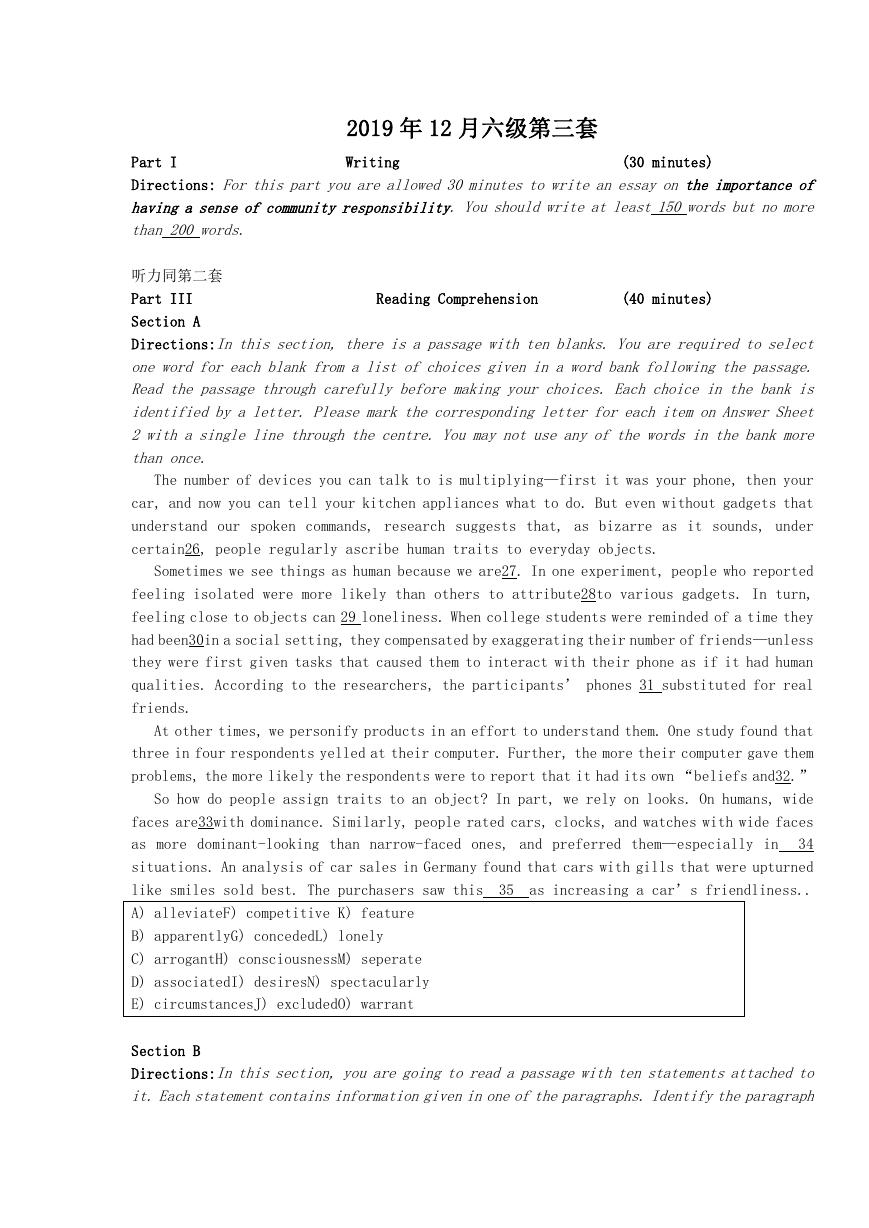
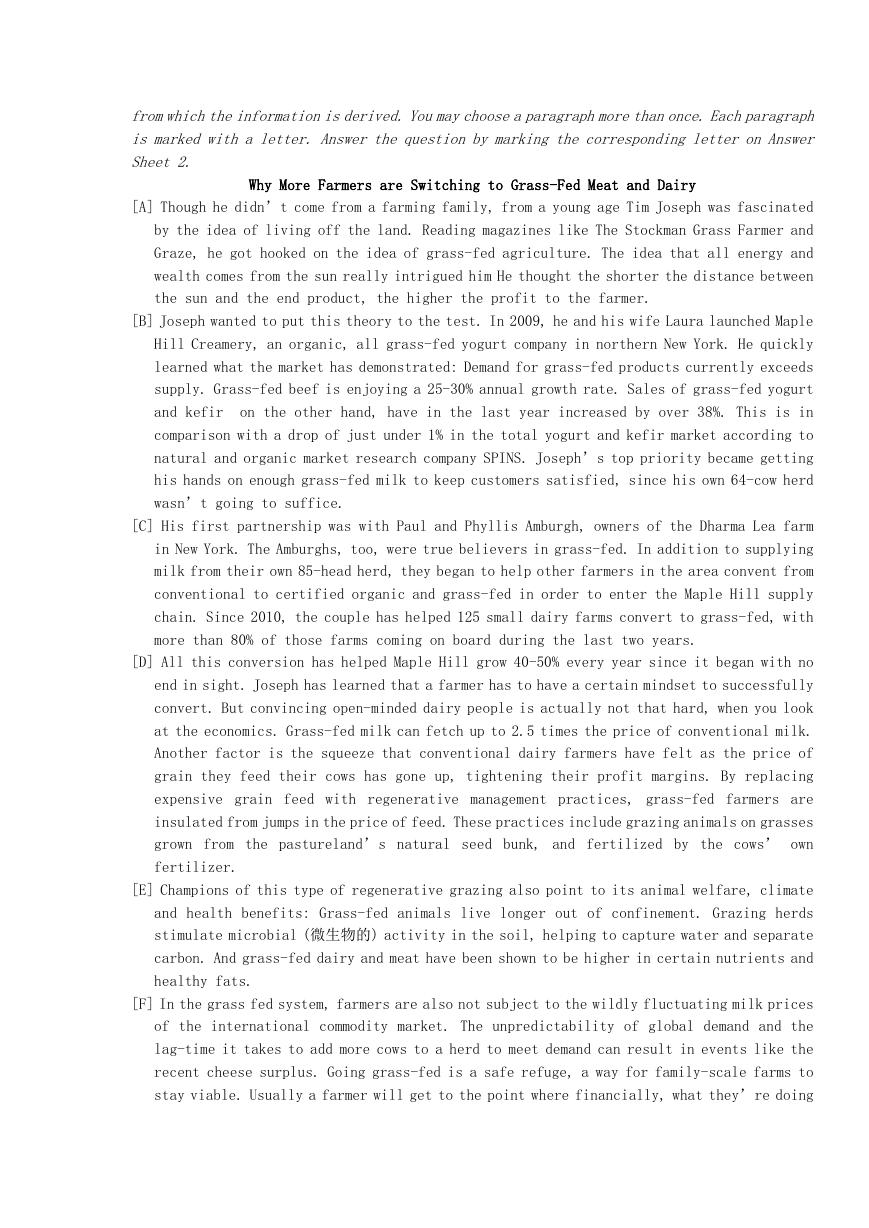

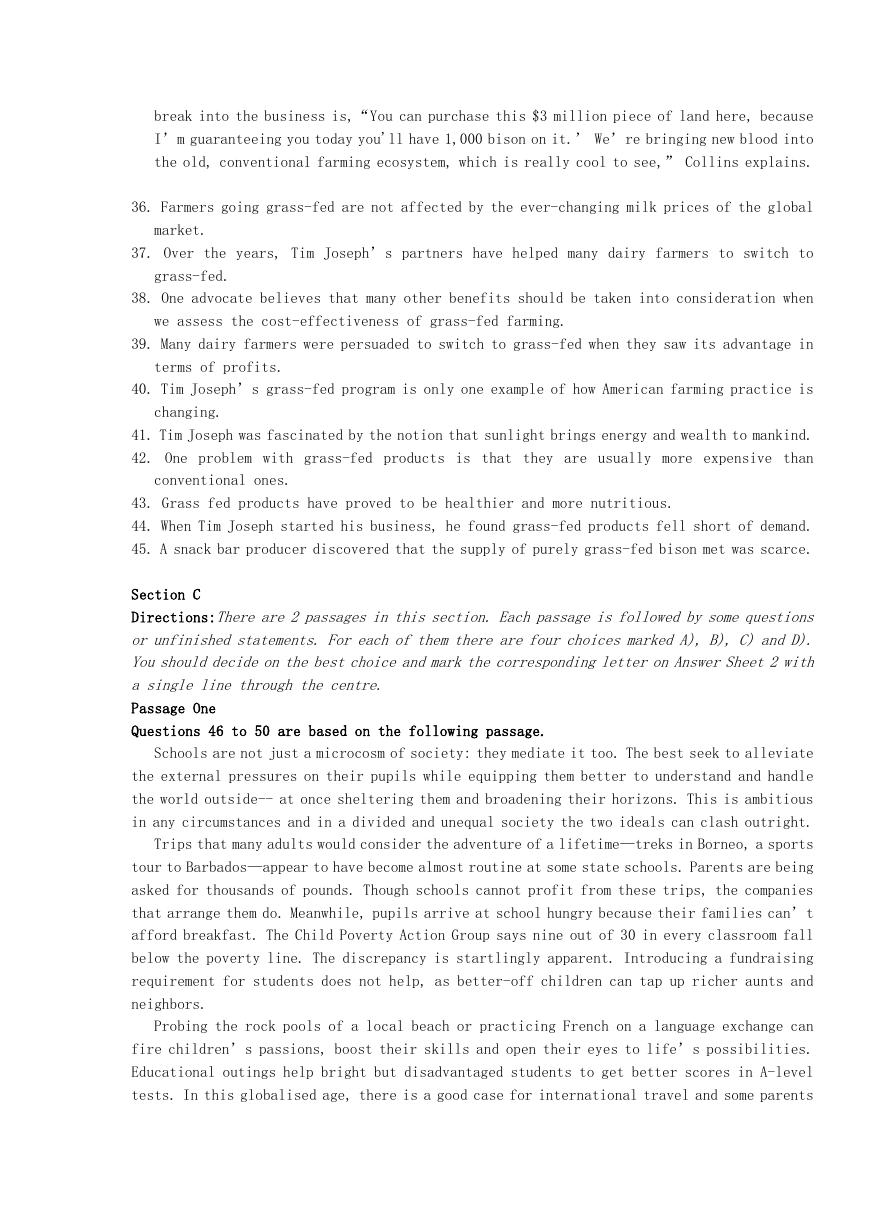
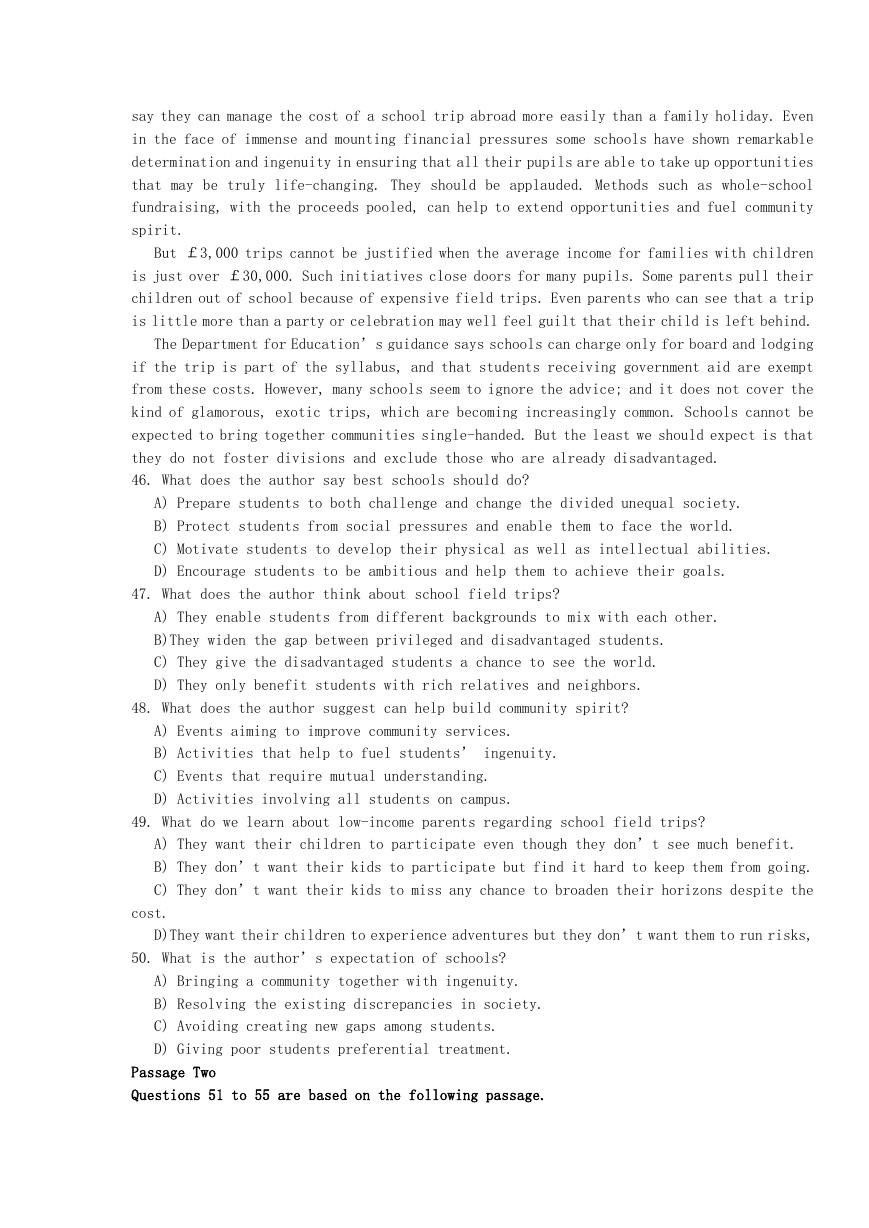
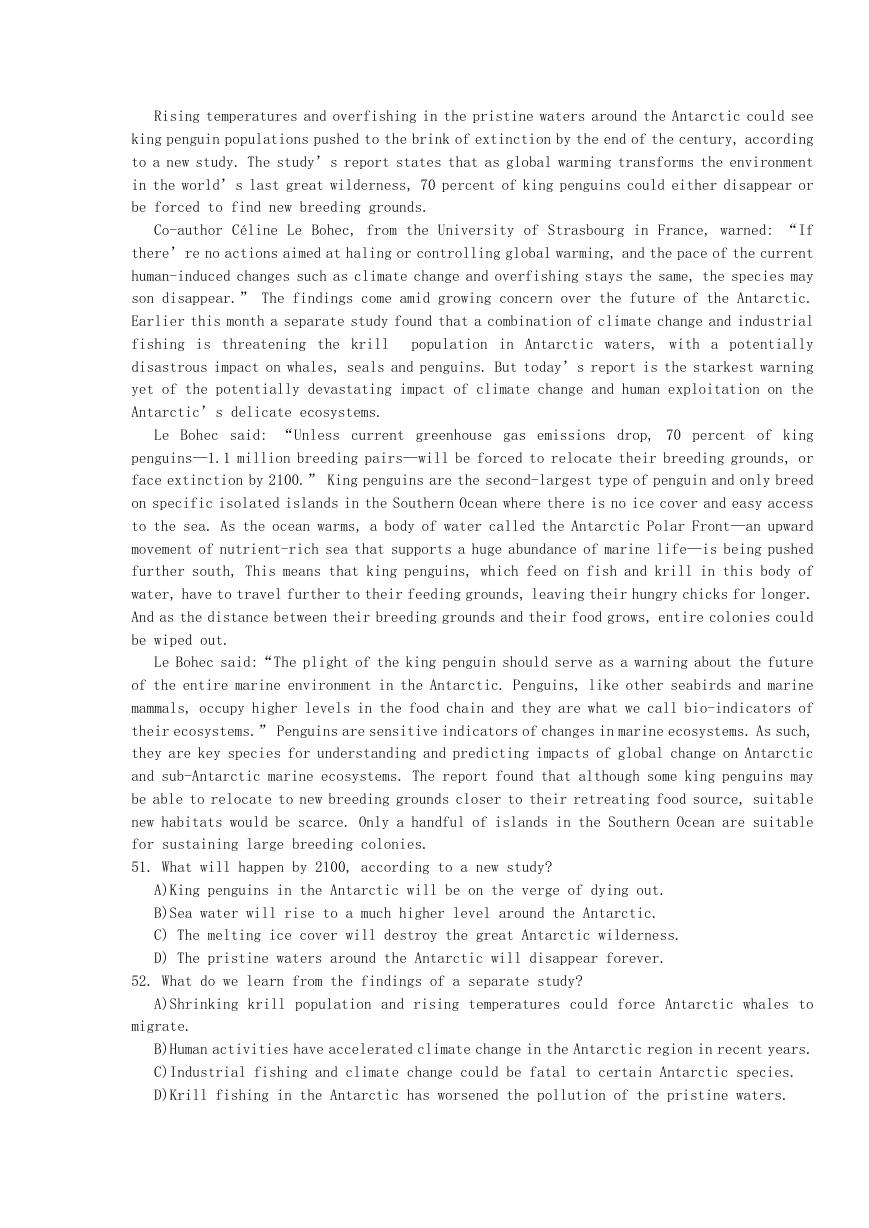
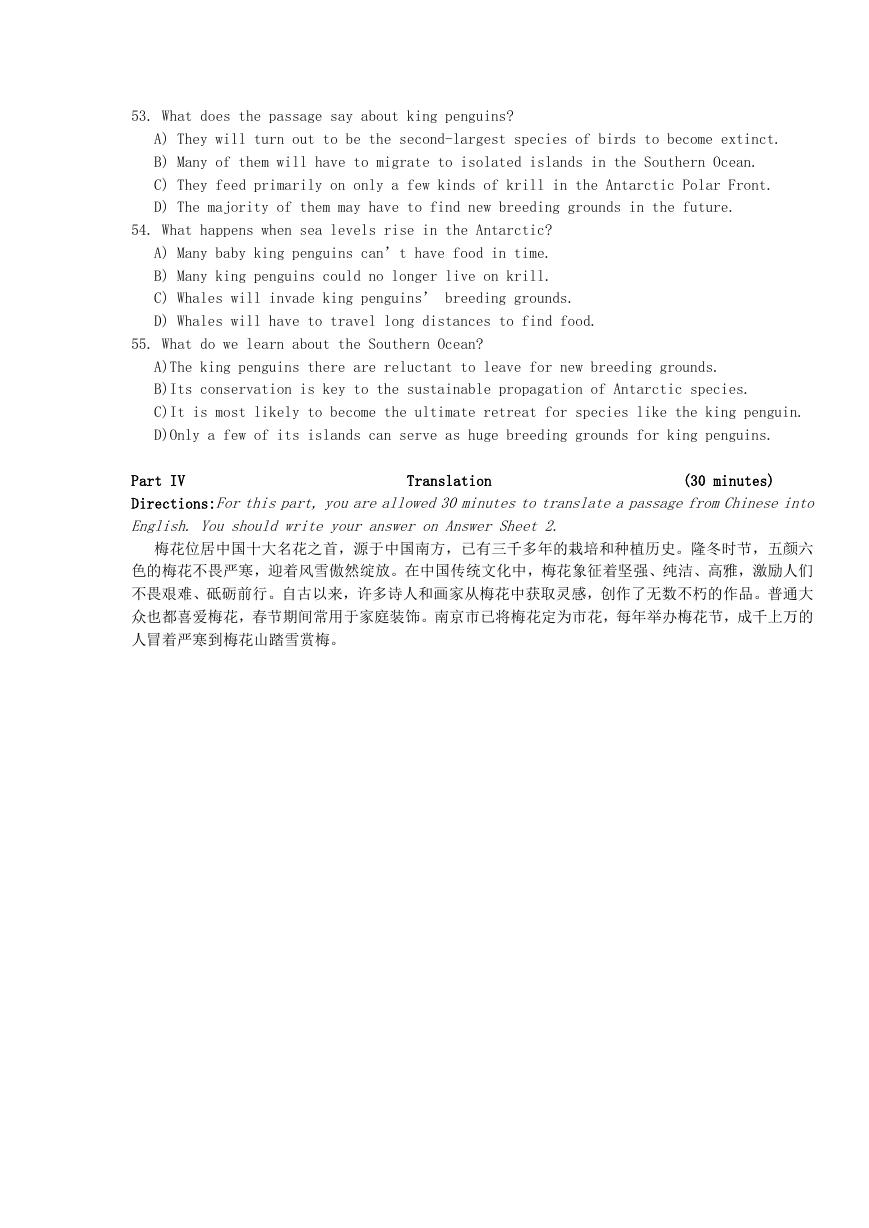







 2023年江西萍乡中考道德与法治真题及答案.doc
2023年江西萍乡中考道德与法治真题及答案.doc 2012年重庆南川中考生物真题及答案.doc
2012年重庆南川中考生物真题及答案.doc 2013年江西师范大学地理学综合及文艺理论基础考研真题.doc
2013年江西师范大学地理学综合及文艺理论基础考研真题.doc 2020年四川甘孜小升初语文真题及答案I卷.doc
2020年四川甘孜小升初语文真题及答案I卷.doc 2020年注册岩土工程师专业基础考试真题及答案.doc
2020年注册岩土工程师专业基础考试真题及答案.doc 2023-2024学年福建省厦门市九年级上学期数学月考试题及答案.doc
2023-2024学年福建省厦门市九年级上学期数学月考试题及答案.doc 2021-2022学年辽宁省沈阳市大东区九年级上学期语文期末试题及答案.doc
2021-2022学年辽宁省沈阳市大东区九年级上学期语文期末试题及答案.doc 2022-2023学年北京东城区初三第一学期物理期末试卷及答案.doc
2022-2023学年北京东城区初三第一学期物理期末试卷及答案.doc 2018上半年江西教师资格初中地理学科知识与教学能力真题及答案.doc
2018上半年江西教师资格初中地理学科知识与教学能力真题及答案.doc 2012年河北国家公务员申论考试真题及答案-省级.doc
2012年河北国家公务员申论考试真题及答案-省级.doc 2020-2021学年江苏省扬州市江都区邵樊片九年级上学期数学第一次质量检测试题及答案.doc
2020-2021学年江苏省扬州市江都区邵樊片九年级上学期数学第一次质量检测试题及答案.doc 2022下半年黑龙江教师资格证中学综合素质真题及答案.doc
2022下半年黑龙江教师资格证中学综合素质真题及答案.doc